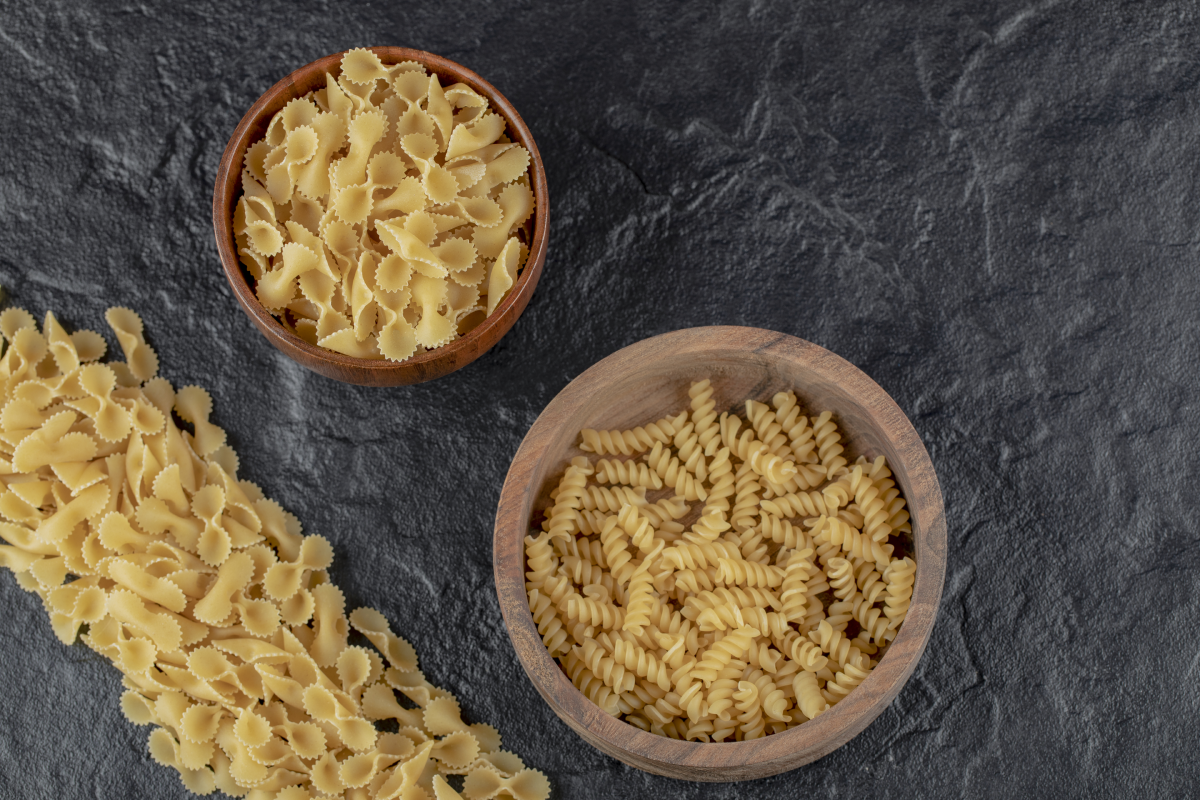Introduction to Ditalini Pasta
Understanding Ditalini Pasta
Ditalini pasta, often hailed as the unsung hero of comfort dishes, is a marvel in the vast sea of Italian pasta types. Its name, translating to “little thimbles,” perfectly encapsulates its charming shape and stature. But don’t let its size fool you; Ditalini packs a flavorful punch and holds a storied place in culinary history.
The Basics of Ditalini Pasta
At its core, Ditalini is about bringing joy and texture to a myriad of dishes. These small, tube-shaped wonders are a testament to the creativity and versatility inherent in Italian cuisine. Far beyond its basic description lies a pasta that is integral to comforting soups like minestrone, yet bold enough to star in vibrant salads and hearty casseroles.
Historical Background and Origin
Tracing back to the heart of Italy, Ditalini’s journey is as rich as the flavors it complements. Born from a need to create a pasta that could embrace and enhance the subtle flavors of broths and sauces, it quickly became a staple in the Italian pantry. Its history is not just a tale of culinary invention, but a story woven into the fabric of Italian culture, symbolizing warmth, family, and tradition.
As we embark on this exploratory voyage through the world of Ditalini pasta, remember that we’re not just talking about food. We’re delving into a tradition that has been passed down through generations, a piece of culinary artistry that continues to evolve and inspire dishes around the globe. For those interested in exploring more delightful seafood pairings with pasta, don’t miss our guide on Garlic Shrimp: A Culinary Delight Everyone Should Try.
The Characteristics of Ditalini Pasta
Understanding the unique attributes of Ditalini pasta is essential for both culinary professionals and enthusiasts alike. This section will shed light on its physical characteristics, texture, and the culinary versatility that makes Ditalini a cherished ingredient in kitchens around the world.
Identifying Ditalini Pasta
Characterized by its tube-like shape and diminutive size, Ditalini stands out for its ability to complement a wide array of dishes. Its structure is perfectly designed to hold onto sauces and broths, making every bite a delightful combination of pasta and the accompanying flavors.
Physical Description and Texture
Ditalini pasta is typically about 1/4 to 1/2 inch in length, with a smooth exterior that can vary slightly depending on the brand. Its firm texture is ideal for creating dishes that require the pasta to maintain its shape and integrity after cooking. When cooked al dente, Ditalini offers a satisfying bite that is both tender and chewy, adding a delightful contrast to the softer textures often found in soups and casseroles.
Culinary Uses and Popular Recipes
The versatility of Ditalini cannot be overstated. While it’s famously used in traditional Italian soups such as minestrone and pasta e fagioli, its applications extend far beyond. Ditalini is equally at home in cold pasta salads, offering a unique texture and shape that sets it apart from more commonly used pasta types. It also excels in baked dishes, where its small size allows it to blend seamlessly with other ingredients, creating a harmonious dish that’s full of flavor and variety.
In the realm of culinary creativity, Ditalini serves as a canvas for a wide range of flavors. From the simplicity of a pasta salad dressed with olive oil and fresh herbs to the complexity of a slow-simmered soup brimming with vegetables and legumes, Ditalini proves time and again that great things indeed come in small packages. For more culinary inspiration, explore The Ultimate Guide to Making Fried Chicken without Buttermilk, where versatility meets flavor.
As we continue to explore the world of Ditalini pasta, we’ll dive deeper into the ways it’s used across various cuisines, share expert tips for cooking it to perfection, and reveal how its nutritional profile can fit into a balanced diet. Stay with us as we journey through the global culinary landscape, discovering the universal appeal of this delightful pasta.
Ditalini Pasta in World Cuisine

Diving into the culinary adventures of Ditalini pasta reveals its global appeal and versatility. This section explores how Ditalini transcends its Italian roots to become a beloved ingredient in a multitude of international dishes, highlighting its adaptability and the creative ways it’s utilized across different cultures.
Global Culinary Adventures with Ditalini
The journey of Ditalini pasta from a traditional Italian staple to a global culinary icon is a testament to its versatility. Across the world, chefs and home cooks alike embrace Ditalini for its unique shape and texture, incorporating it into a variety of dishes that reflect local flavors and traditions.
Ditalini in Italian Cuisine
In Italy, Ditalini is most commonly associated with soups such as Minestrone and Pasta e Fagioli. These dishes showcase Ditalini’s ability to complement a rich broth, absorbing flavors while maintaining its distinctive texture. Beyond soups, Italian families often use Ditalini in pasta salads and as a base for lighter, vegetable-focused dishes, celebrating the pasta’s ability to blend seamlessly with seasonal ingredients.
Ditalini Beyond Italy: A Look at Global Dishes
As Ditalini pasta ventured beyond Italian borders, it found a place in the hearts and kitchens of diverse cultures. In the United States, it’s a popular choice for pasta salads and macaroni dishes, appreciated for its bite-sized shape and how well it pairs with creamy dressings and sauces. Middle Eastern cuisines have adopted Ditalini in their own versions of broth-based soups, adding spices like cumin and coriander to introduce a new dimension to the pasta’s flavor profile.
IIn more tropical climates, Ditalini is used in cold salads mixed with fruits and a tangy dressing, proving its flexibility in both savory and slightly sweet dishes. This ability to transcend culinary boundaries demonstrates Ditalini’s universal appeal and its potential to bring people together over a shared love for pasta. For an in-depth exploration of pasta’s versatility, consider our comprehensive Ditalini Pasta Guide: Recipes & Tips.
As we continue our exploration of Ditalini pasta, we’ll uncover the secrets to cooking it perfectly every time, delve into its nutritional benefits, and answer the most common questions surrounding this versatile pasta. Join us as we celebrate the global journey of Ditalini, a small pasta with a big impact on world cuisine.
Cooking Techniques and Tips

Mastering the art of cooking Ditalini pasta is key to unlocking its full potential in a variety of dishes. This section offers expert tips and tricks to ensure your Ditalini is cooked to perfection, enhancing its texture and flavor to complement any recipe.
Mastering Ditalini Pasta: Cooking Tips and Tricks
The secret to cooking Ditalini pasta lies in understanding its unique characteristics and how they interact with different ingredients and cooking methods. By following these guidelines, you can achieve the ideal texture and flavor profile for your dishes.
Best Practices for Cooking Ditalini
- Salt the Water: Adding salt to your boiling water is crucial. It seasons the pasta from the inside out, giving depth to the overall flavor of your dish.
- Boiling Time: Keep an eye on the cooking time. Ditalini usually cooks in about 8 to 10 minutes, but it’s best to start checking for doneness around the 7-minute mark to ensure it’s perfectly al dente.
- Stir Occasionally: Prevent sticking by giving the pasta a gentle stir every now and then during the cooking process. This is especially important at the beginning when the pasta is most likely to clump together.
- Reserve Pasta Water: Before draining, save a cup of the pasta water. Its starchy goodness can be used to adjust the consistency of your sauce, enhancing the dish’s overall texture and flavor.
Pairing Ditalini with Sauces and Ingredients
Ditalini pasta’s small size and tube shape make it an excellent candidate for a wide range of sauces and ingredients. Here are some pairing tips to elevate your Ditalini dishes:
- Rich, Creamy Sauces: Ditalini holds up well against thicker sauces, making it a great choice for creamy or cheesy recipes.
- Brothy Soups: Its ability to absorb flavors without becoming mushy makes it ideal for soups and stews.
- Vegetable-Based Sauces: Use Ditalini in dishes with finely chopped vegetables or legumes. Its size allows for a harmonious blend of pasta and produce in every bite.
By incorporating these cooking techniques and pairing tips, you can maximize the culinary potential of Ditalini pasta. Whether you’re preparing a hearty soup, a refreshing salad, or a decadent baked dish, these tips will help you achieve delicious results that highlight the best qualities of this versatile pasta. For chefs and home cooks looking to deepen their culinary expertise, our article on alternative dairy solutions offers valuable insights into ingredient substitutions and more.
Stay tuned as we delve into the nutritional benefits of Ditalini pasta, offering insights into how it can fit into a healthy diet, and rounding out our comprehensive guide with answers to frequently asked questions.
Nutritional Profile of Ditalini Pasta
FAQs
Exploring the delightful world of Ditalini pasta, we’ve delved into its origins, uses, and health benefits. Now, let’s tackle some common questions to enhance your pasta knowledge.
Answering Your Ditalini Pasta Queries
Q: What is another name for Ditalini Pasta?
A: Known as “little thimbles” for its shape, Ditalini typically doesn’t have another name. This nickname highlights its unique, functional design.
Q: Is Ditalini a pastina?
A: Partly. It fits within the pastina family due to its tiny shape. Though pastina usually refers to smaller shapes, Ditalini’s role and size align it with pastina broadly.
Q: How do Ditalini and Tubetti pasta differ?
A: Their main differences are size and shape. Ditalini, shorter and tube-like, is perfect for soups and salads. Tubetti, a bit larger, serves similar purposes but may offer a distinct texture.
Q: How do you pronounce Ditalini?
A: It’s pronounced “dee-tah-LEE-nee,” with emphasis on the third syllable. This pronunciation reflects its Italian roots.
These answers aim to clear up uncertainties about Ditalini pasta. Now, you’re better equipped to use Ditalini to add Italian flair and innovation to your dishes.
Conclusion and Final Thoughts
Reflecting on our Ditalini pasta journey, we’ve seen its versatility, cultural impact, and nutritional value. Beyond being a simple ingredient, Ditalini is a creative, comforting culinary staple.
Embracing Ditalini’s Versatility
Its small size and robust texture open up endless kitchen possibilities. Ditalini thrives in soups, salads, and casseroles, adapting to various flavors and traditions. This adaptability encourages culinary innovation and experimentation.
Cooking with Ditalini is an exploratory journey. Each dish tells a story, blending tradition with creativity. Ditalini not only enhances recipes but also weaves a rich tapestry of flavors and memories.
We hope to have inspired you with Ditalini pasta’s potential. Let it spark your creativity, enrich your meals, and bring joy to your kitchen adventures.
Thank you for joining this pasta exploration. May your culinary endeavors with Ditalini be joyful and delicious. Here’s to many more delightful experiences ahead!

